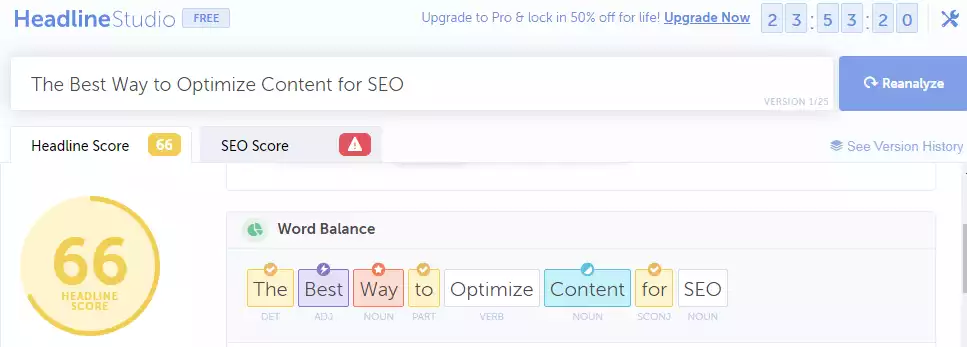The Best Ways to Optimize Content for SEO
The term content optimization often refers to search engine optimization (SEO). However, that does not mean you should optimize your content specifically for search engines. On the contrary, your content will become search engine friendly when it is optimized for humans. Producing high-quality, optimized content can increase your site’s traffic for free. Here are some ways to optimize your content to perform better and why this is so important.
What is Content Optimization Strategy?
The goal of content optimization as we described in How to Improve SEO Rankings? is to improve the content to meet its desired objective, whether ranking on the first page of Google, increasing social shares, or attracting your best customers.Content Optimization Tips and Techniques
1- Your blog’s target audience should be identified.
Your blog strategy must consider who is your primary audience and what you want them to do when they click on your article, no matter what industry your blog targets.A buyer persona can help you target readers, based on their buying habits, demographics, and psychographics. Without this insight, you may be producing grammatically correct and accurate content that doesn’t speak to your target audience on a personal level.2-Perform keyword research.
After selecting your target audience and developing your buyer persona, it’s time to determine what content your readers will enjoy. If you do not have a strategy, keyword research can be a heavy task. To narrow or expand your scope, I recommend starting with the topics your blog will cover. For an in-depth tutorial, check out The Best Way to Research Keywords for SEO.3-Add visuals.
On the search engine results page, visual elements such as images and videos are among the most common visual features that search engines value for certain keywords. Designing creative graphics, using original photos and videos, and adding descriptive alt text to every visual element within your blog post will help you get a coveted spot in an image pack or a video snippet. In addition to determining whether or not your image or video appears in the SERP and how highly it appears, alt text is also essential for screen readers, which allows visually impaired people to use your blog content.4- Make your title catchy.
A catchy title piques the reader’s curiosity and influences whether they will click on your blog post or keep scrolling. A catchy title uses data, asks a question, or leads with curiosity.With Coscheduler’s Headline Analyzer, you can determine the elements of a catchy title, including power, emotion, uncommon, and common words. If you use these words in the right proportions, your blog title will grab your readers’ eyes.The following is an example of a catchy headline with a Coschedule Headline Analyzer Score of 66:
According to Coschedule, the word content, highlighted in blue, builds trust with the reader and implies that this article has a strong point of view.
The color purple is a powerful word. It attracts readers’ attention and makes them curious about the content.
Furthermore, this title also contains red words that are uncommon. Unusual words are rarer than common words but add interest to your headline. Great headlines consist of 10-20% uncommon words.
5- Consider the reader’s experience.
Writers and SEOs tell you that the reader experience is essential for a successful blog post. Readability, formatting, and page speed all play a part in the reader experience. Therefore, you should write clear, comprehensive content on your topic and be accurate based on the latest trends and data. It is also essential to organize the content using headings and subheadings so the reader can quickly scan the content to find the information they need. Additionally, images and videos contribute to page speed. You should keep image file sizes as small as possible (250 KB is a good starting point) and embed as few videos as possible on a single page. You will be on your way to publishing an SEO-optimized article if you focus on what your readers want to know and organize the post accordingly.6- Continually add new content
To optimize your content, always post new content; search engines and your readers love new content.7- Take advantage of social media.
Social media is essential when it comes to content optimization, and simply posting a link isn’t enough. If you posted your blog once and then gave up on it, you aren’t optimizing your page well. Instead, use social media sites to build relationships with relevant users and connections, share other users’ content too, provide feedback, and go beyond posting.8- Make sure to include an enticing call-to-action.
A CTA (Call To Action) encourages your reader to take the next step in their journey through your blog. Creating a CTA relevant to your current post is essential and flows naturally with the rest of the content is important. Whether you’re trying to sell the reader something, offer a newsletter subscription, or encourage them to consume more of your content, you’ll need a compelling CTA. Get creative and experiment with your CTAs. Buttons, hyperlinks, and widgets are some of the most common CTAs, and they all serve different purposes. If you want the reader to make a purchase, you should add a bold, visible CTA. On the other hand, by providing a hyperlink in your conclusion, you can easily entice them to check out another blog post.9- Keep it Clean
Lastly, keep in mind that a search engine won’t publish illegal or hard-to-find content. Hence, make sure that your code is clean and organized and that you use HTML and CSS layouts so that search engines can find your post easily. Also, be aware that anything illegal (unauthorized use of copyrighted content) will not be published; To avoid raising red flags, create your content and be creative.Conclusion
You can optimize your content by ensuring search engines understand what you do. If they can’t, search engines won’t be able to help users find you. By optimizing your content, search engines can determine what your content—and, by extension, your business—is all about. Once your site is ranked higher than others, users will be directed directly to it.Download this Article in PDF format

Arashtad Custom Services
In Arashtad, we have gathered a professional team of developers who are working in fields such as 3D websites, 3D games, metaverses, and other types of WebGL and 3D applications as well as blockchain development.
Arashtad Services
Drop us a message and tell us about your ideas.
Fill in the Form
Blockchain Development



